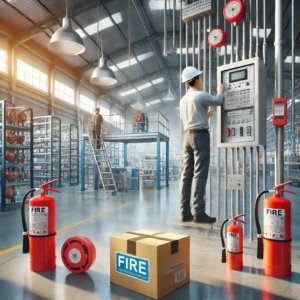Fire safety engineering has seen remarkable advancements with the integration of AI-powered fire detection and smart IoT-based suppression systems. Modern solutions, like our advanced fire protection systems, enhance response times and minimize damage in critical situations. Additionally, industries are now prioritizing fire-resistant building materials to improve structural safety. Global standards such as NFPA fire safety guidelines and OSHA fire prevention regulations continue to shape innovative fire prevention strategies. These advancements collectively contribute to a safer, more resilient approach to fire safety in commercial and industrial space
Advances in Fire Safety Engineering: What's New
Table of Contents
Fire safety is crucial for business owners, facility managers, and safety officers, making fire prevention and emergency response top priorities. Recent advancements in fire safety technology have significantly improved our ability to save lives and protect property.
Modern fire safety systems now seamlessly integrate with building management systems, ensuring fire safety measures are implemented quickly and efficiently. In this article, we’ll explore the latest trends and technologies in fire safety engineering.
If you manage or own a building, staying informed about the latest fire prevention tools and strategies is essential. Let’s dive into some of the cutting-edge technologies that are enhancing fire safety.

Smarter Fire Alarms
New smoke detectors are very clever. They can:
- Tell the difference between real fires and false alarms
- Warn about fire risks before they happen
- Call for help faster
These new alarms work with your building’s systems. They can shut down airflow and doors to stop fumes from a fire, thereby halting its spreading.
How do they work? These smart smoke alarms think with the help of microcomputers. They can distinguish between smoke caused by a fire and that caused by burned toast. That means fewer false alarms, and faster action when there is real danger.
Some alarms even use sound to check the air. They can hear fire before you see it. This gives you more time to get out safely.
Tougher Building Materials
New materials make buildings safer:
- Special coatings that puff up when hot, protect the building
- Concrete that can fix small cracks by itself
- Glass that stays strong in high heat
These give people more time to get out if there’s a fire.
Let’s discuss these materials:
Special coatings can be considered magic paints. When encountering fire and heating up, they expand massively. Thereby, a thick layer is formed in return, protecting the main parts of the building from catching fire.
Self-healing concrete works with capsules inside it. When you start a crack, these capsules break open. They release a special glue that fills the crack. This stops fire from getting through small spaces.
The tough glass is made of many layers. Between the layers is a clear, strong material. When fire heats the glass, this material turns into a shield. It holds the glass together and keeps the fire out.
Watching for Fires All the Time
New fire alarm systems offer:
- Round-the-clock checking
- Quick alerts to your phone
- Details about where the fire is and how it’s spreading
These systems never sleep. They keep an eye on your building day and night. If they spot trouble, they send a message right away. You’ll know about a fire as soon as it starts, even if you’re not there.
The alerts tell you exactly where the problem is. Is it in the kitchen? The storage room? You’ll know right away. This helps you make quick choices about what to do next.
Training with Virtual Reality
The virtual games nowadays are used by fire safety experts to:
- Simulate fires for training
- Test escape plans safely
- Help people to make better choices during emergencies
This helps a person to get ready for the real thing.
In other words, virtual reality is very near to a video game. It allows people to practice dealing with fires without any danger. They will learn how fires spread and how to react.
This training keeps people cool during actual fires. They have experienced it in the game before, so they know how to behave. It is a safe way to gain some experience.
Using Drones to Check Fires
Drones with flying cameras that have heat sensors can:
- See how a fire is spreading
- Locate hot spots within large buildings
- Indicate firefighters’ safest way in
This is very helpful in fires involving tall buildings or those where there could be tricky situations.
These can safely fly around buildings in flames, returning pictures and heat maps. This shows firefighters where the fire is worst and where it might go next.
With drones, a whole big building can be checked in a hurry. They can spot dangers that people on the ground might miss, keeping firefighters safer and helping them snuff out fires faster
Smarter Sprinklers
New sprinkler systems use sensors to:
- Turn on only where there’s fire
- Change the volume of water they dispense depending on the fire
- Reduce water damage where there’s no fire
These systems extinguish fires more effectively and with less damage.
Old sprinklers douse everything, even parts of the building that are not on fire. Well, this new system is much smarter. It only uses water where it’s needed.
They can even adjust how much water they are spraying. A small fire gets less water than a large one, so this means less damage to the water in your building and less stuff inside it.
Using Artificial Intelligence to Predict Fires
Smart computer programs can now:
- Look at lots of info to guess where fires might start
- Suggest ways to stop fires before they happen
- Help fire departments plan better
This prevents many fires from occurring in the first place.
Maybe it seems that a certain area needs more fire exits. Or it might spot that some equipment is getting old and risky. By following these tips, you can stop many fires before they start.
Fire departments use this AI, too. It helps them know where to put fire stations and how many firefighters to have ready. In other words, this makes sure that help is going to get to you fast if you need it.
Wrapping Up
These new tools for fire safety make your buildings safer than ever, though they will not replace basic fire safety. We will still need fire drills, clear escape ways, and well-kept safety gear.
If you’re in charge of a building, knowledge about such new tools is what makes the place safe. No matter what, the main goal is always safety for people and the protection of your buildings.
Want to know more? Think about taking a fire safety class or talking to a fire expert. They can help you pick the best safety tools for your building.
Stay safe, keep learning, and use these new tools to make your building safer for everyone. Fire safety tech keeps getting better, so stay up to date. Your quick action with these new tools could save lives and protect your business.
Keep exploring and improving your fire safety plans!
In conclusion, staying updated with the latest fire safety technologies and trends is essential for ensuring the safety of both lives and property. By integrating modern fire safety systems with building management, businesses can be better prepared for fire emergencies. To learn more about fire safety standards and practices, explore the following resources:
- For comprehensive fire safety standards and guidelines, visit the National Fire Protection Association (NFPA).
- Stay informed about workplace fire safety regulations through OSHA’s Fire Safety Guidelines.
- Explore advanced fire safety engineering practices with the Society of Fire Protection Engineers (SFPE).
- For fire prevention strategies and emergency preparedness, check out FEMA’s Fire Prevention Resources.
- Learn more about sustainable fire suppression technologies from the Environmental Protection Agency (EPA).
Know about us more
- The Importance of Fire Protection Systems in Industrial Settings
This blog provides context on why fire protection systems are critical in industrial environments, complementing the discussion on new advancements in fire safety engineering. - How to Implement a Foam Fire Suppression System for Industrial Facilities
This blog offers practical guidance on implementing a specific advanced fire suppression system, aligning with the focus on innovative fire safety solutions.
Useful Links to understand more
- National Fire Protection Association (NFPA) – Journal
The NFPA Journal provides updates on the latest trends and innovations in fire safety engineering, offering authoritative insights for professionals. - Society of Fire Protection Engineers (SFPE) – Fire Protection Engineering Magazine
SFPE’s magazine covers cutting-edge developments in fire safety engineering, providing valuable resources for staying informed about industry advancements.
Related Blog
The Ultimate Guide to Emergency Response Systems for Industrial Facilities in 2025
This blog explores modern emergency response systems, complementing the focus on advanced fire safety engineering by addressing broader safety solutions.
Exploring Modern Fire Safety Solutions?
SRJ Piping India brings you the latest in fire safety engineering—designed for smarter, faster, and safer industrial protection.
